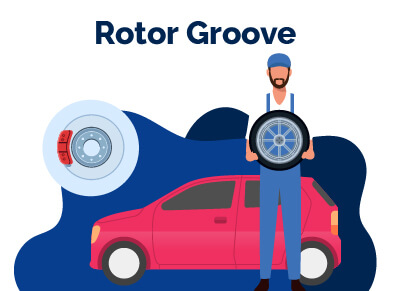Rotor Grooves (Everything You Need To Know)
July 21, 2023


Chris is Head of Content for FindTheBestCarPrice and is based out of Philadelphia, PA. As a seasoned automotive industry analyst and car enthusiast, he ensures the highest level of quality across all our content and curates our picks for the best deals each month.
Chris studied information systems and marketing at Drexel University and writes about a wide range of topics ranging from car buying tips to troubleshooting common mechanical issues.
When he’s not thinking about cars, he likes to stay in with his dog and make an “attempt” to finish a crossword puzzle (he’s not quite at the Saturday/Sunday level…yet). As a former cheesemonger, Chris still has a “sharp” passion for all things cheese, and his fridge is always loaded with it!
Chris also has a passion for things that go fast, and drones are no exception. He spends some of his time writing for Dronesourced.
A brake rotor groove can be a visible sign that a brake system is showing signs of wear and aging. Prolonged exposure to the cyclic forces of friction and pressure exerted upon the brake rotor can gradually induce surface irregularities, thereby engendering the creation of grooves and ridges on the braking surface.
This can lead to reduced braking performance, increased stopping distance, and potential safety hazards.
The manifestation of a brake rotor groove may also serve as a harbinger of the brake pad's approaching obsolescence, signifying the need for a prompt replacement.
Various factors, including high mileage, heavy use, and exposure to extreme temperatures, can cause brake rotor grooves.
Timely inspection and maintenance of brake components help identify and address issues before they compromise the safety and performance of the vehicle.
Table of Contents
What Are Brake Rotors?
Brake rotors, circular metallic disks interlinked to the wheels of an automobile, are fitted with four rotors, one for each wheel. The rotors' principal role is to decelerate the revolution of the wheels through the application of friction.
The brake rotor mechanism is activated when the calipers compress the brake pads of the car, prompting the pads to generate friction with the surface of the rotors.
This friction eventually results in the deceleration of wheel rotation, thereby reducing the automobile's velocity.
What Causes Rotor Grooves?
As the rotors heat up from the intense friction of braking, the metal undergoes a softening process, enabling the "grooving" phenomenon you previously mentioned to occur due to the pads.
In contrast, the pads, composed of asbestos, ceramic, and others, exhibit superior heat resistance, surpassing that of the rotors.
This heightened resilience allows them to endure the high temperatures generated during braking, leading to the creation of grooves on the super-heated rotors.
It is worth noting that the hardness of the pads is not greater than that of the rotors, as replacing rotors instead of pads would be a frequent necessity otherwise.
The pads are fashioned from compressed particles, some of which possess considerable hardness.
Unless the pads wear down to the rivets, causing deep grooves, there is no need for concern regarding "turning" or shaving the rotors with each pad replacement.
If the rotors feel smooth to the touch, it is advisable to refrain from any further intervention. Let the debates ensue on this forum.
When brake pads are excessively worn, they can leave conspicuous circular grooves etched into the rotor. If such grooves are apparent, it is imperative to replace both the brake pads and hardware while also considering the need for rotor servicing or replacement.
It is crucial to have a skilled mechanic thoroughly inspect both the brake pads and rotors to diagnose the issue accurately.
In addition, slotted and drilled rotors dissipate heat in the rotors, promoting quicker cooling. An insightful tip is to inch forward in your vehicle after coming to a hard stop in traffic or at a traffic light, particularly after exiting the interstate.
Doing so while the rotors and pads are still hot prevents the pads from lingering in one spot on the rotors, potentially causing a soft spot that could result in warping.
By rolling forward ever so slightly, you ensure that the pads move around the rotors, preventing them from remaining stationary.
How To Prevent Rotor Groove
As the brake pad friction material wears away, the pad backing and rotor rapidly deteriorate.
The rotor's thickness gradually wears below the minimum safe limit, even if the pads have not worn down to the metal.
However, prolonging excessively worn pads accelerates the rotor's degradation and may require its replacement, especially if it could have been machined before the brake went from metal to metal.
In addition to the rotors, the brake calipers are also at risk of damage if the brakes are not attended to promptly.
If the pads are worn too thin or ejected, the caliper piston can hyper-extend and dislocate, leading to brake fluid leakage. In such cases, the calipers must be replaced, incurring additional costs that could have been avoided.
Determining when to replace brake components is only sometimes straightforward. Consultation with a trusted mechanic is advisable to determine the brake system's lifespan.
As tire rotation should occur at least twice annually, this offers a convenient opportunity to have the brakes checked for pad thickness and hardware condition.
What Are Rotors Used for, and How Do They Work?
Brake rotors, in conjunction with other braking components, are used to decelerate and halt your vehicle.
Without brake rotors, the vehicle's capacity to halt safely or decelerate after acceleration would be limited to gradual slowing caused by air and road friction.
Furthermore, your vehicle incorporates brake pads that clamp down on the wheels to halt their rotation. The rotors serve as the surface upon which these pads exert pressure.
These rotors are typically composed of iron to ensure long-term durability. Nevertheless, brake rotors necessitate maintenance and replacement periodically.
When you apply pressure to the brake pedal, the brake rotors become operational. The brake pads are pressed against the rotors after depressing the brake pedal.
Bear in mind that each wheel is equipped with a single rotor. When you apply the brakes, all four wheels slow down simultaneously.
As the brake pads come into contact with the brake rotors, friction is generated, gradually reducing the rotation of your vehicle's wheels (assuming you are no longer accelerating). This process of decelerating the wheels through friction produces intense heat.
Therefore, brake rotors are fashioned from steel to withstand this heat. Additionally, brake rotors usually feature ribs or gaps to facilitate the efficient dissipation of heat during the braking process.
Brake rotor varieties are distinguished based on the types of ribs integrated into their designs.
Upon releasing the brake pedal, the brake pads cease their pressure on the rotors, allowing the wheels to revolve freely again without impediment.
Brake Rotors Replacement Cost
It is advisable to replace your brake rotors periodically. This is because braking will, over time, erode the steel surfaces of both the rotors and brake pads.
As these components wear down, your braking efficiency and reliability will decrease, posing hazards while driving.
Make it a habit to inspect your brake rotors as part of your annual vehicle maintenance routine. Alternatively, take the time to inspect your brake rotors on your own.
You will also most likely feel a decrease in braking responsiveness and immediacy as your rotors deteriorate.
The customary expense of an ordinary brake rotor replacement service usually falls within the range of $400 to $500, contingent upon the rotor category, the vehicle's make and model, and the extent of labor required.
However, if you possess the requisite knowledge and experience, you may purchase rotors at a lower cost and perform the maintenance yourself.
Best Car Deals by Category
Frequently Asked Questions
What is a rotor groove?
A rotor groove is a visible mark or groove that appears on the surface of a brake rotor. It is a sign of wear and tear on the rotor and can affect its performance.
How does a rotor groove form?
A rotor groove is typically caused by the brake pad wearing down the surface of the rotor over time. This can happen due to normal wear and tear or excessive braking.
What are the signs of a rotor groove?
Signs of a rotor groove include a pulsating or vibrating brake pedal, a grinding or squeaking noise when braking, and a decrease in braking performance.
Can a rotor groove be repaired?
In most cases, a rotor groove cannot be repaired, and the rotor must be replaced. Attempting to repair a rotor groove can compromise the safety and reliability of the braking system.
How long does it take for a rotor groove to affect braking performance?
The time it takes for a rotor groove to affect braking performance can vary depending on the severity of the groove and the driving conditions. However, it is essential to have the brake system inspected regularly to catch any potential issues before they become a safety hazard.
How much does it cost to replace a rotor with a groove?
The cost of replacing a rotor with a groove can vary depending on the make and model of the vehicle, the type of rotor, and the labor cost. Replacing rotors with grooves can cost between $300 and $700 per axle.
Posted in Car Buying Tips, Car Troubleshooting |




